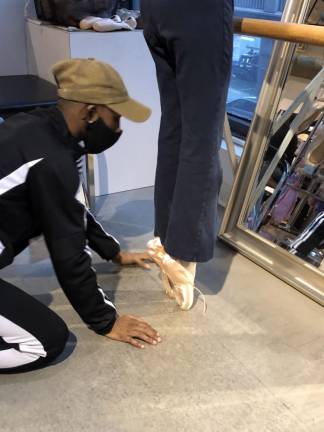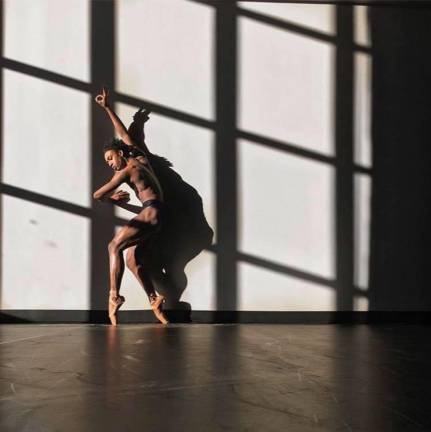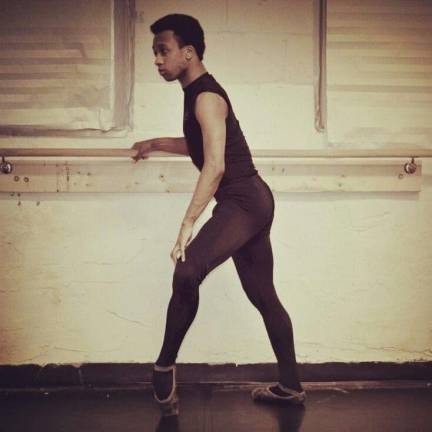In the world of Harry Potter, the wand chooses the wizard. Likewise, at Capezio’s on West 50th Street in Manhattan, the toe shoe chooses the dancer - or more precisely - Tevin Johnson does. So how does someone become an expert ballet pointe shoe fitter? I asked Tevin all about his unique and specialized odd job.
How did you start your pointe shoe fitting career?
Well, I am dancer myself, first and foremost. I taught myself ballet when I was very young. As a young man, I decided I wanted to try pointe shoes, even though it is usually for girls. I went on pointe when I was 16 and I did a lot of pointe work throughout college as well. Then, I started getting more familiar with pointe shoes, not just Capezio’s, but other pointe shoe brands in general. After college, I started working with the Capezio’s store and I’ve been there for three years now fitting young dancers and making sure their first pair of toe shoes fit perfectly. I also teach ballet, modern, and pre-pointe at a studio in Plainfield, NJ. My youngest students range from 6-11 years old, while the older girls range from 11-14 to 14-17 years old.
What makes a good shoe fit?
Finding the right pointe shoe takes patience. Fittings are usually by appointment and can take up to an hour, and I’ve seen them go to up to an hour and a half. It usually takes longer for dance students getting their first pointe shoes because the student doesn’t know what they should be feeling, so we have to try on up to four or five pair before they say, “This one feels a lot better than the last ones.”
When fitting someone, we’re looking to see if the toes are directly touching the box; if the toes are going into the box; if the foot is wider than the box, or if the toes are scrunching, etc. It’s really a lot about the box and looking for flat, even toes when the foot is flat. And when the dancer goes up on pointe, we’re looking to see if she’s sinking or floating. We don’t want her to be slowly dissolving into the shoe, we want her to be floating.
What age do most dancers go on pointe?
Typically, the appropriate age for dancers to go on pointe is between 13-14, but that can vary based on their own personal strength and how strong their ankles are.
Have you fitted anyone famous?
I should not really reveal. However, I can say that managers and agencies will sometimes come in to show me a photo of a person’s feet and toes who’s not experienced on pointe to find out what kind of shoe they should be in. Basically, I get asked for my for expert advice. I also fit models for pointe photo shoots, since we don’t want the models to be in a shoe that doesn’t fit for the sake of the photo as this can be dangerous. The model could break an ankle with a poorly fitted shoe even in a photo shoot. Also, we want it to look right and accurate and it wouldn’t look right unless the shoe fits correctly.
What is the worst part of the job?
Probably, I would have to say that when overbearing mothers or stage moms and dance teachers try to control the fitting. It’s just frustrating because I want the child to describe their personal experience in their own words as this is a very personal experience. I want the child getting fitted to describe their sensations and how it feels rather than their parent or teacher telling them what they should be feeling and asking if it’s too big or too small. This can cause the young dancer, especially one who’s never gone on pointe before, to think beyond what’s necessary for the fitting. In the end, it’s best if parents and teachers let me work with the dancer. Trust me, I know what I’m doing.
What’s the best part of the job?
The best part for me is definitely giving kids their first pointe shoes and seeing their excitement because I was there and I was them. I just love seeing their reactions. When we discover ballet for the first time, we don’t see dancers with flat ballet slippers, we see dancers on pointe. There is a kind of glorification. Also, moving onto pointe is a milestone in someone’s training and it shows that ballet is always evolving and that there is a new, higher place to go. In baseball, you try to hit a homerun every time, but in ballet, you may do the same thing every day, but it has a different outcome.
So as Nutcracker season begins, and you enjoy watching the dancers twirling on pointe, don’t forget to thank the elf behind the scenes who helped to make it possible.
Lea Efran is a NYC high school sophomore. She plays volleyball, does jiu-jitsu and is a Stone Soup Magazine honoree. Her younger sister was recently fitted by Tevin Johnson.


